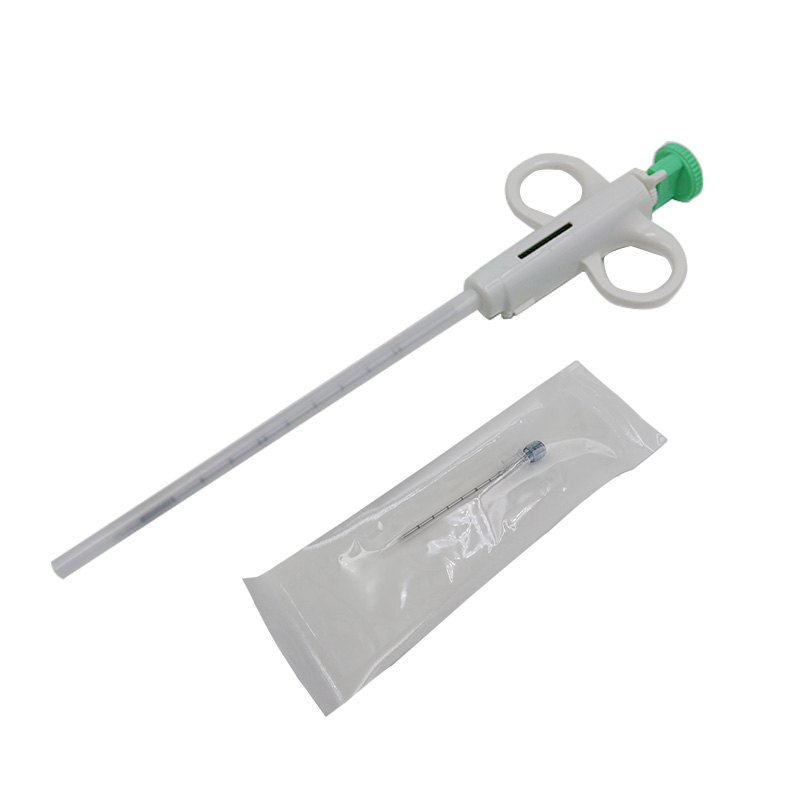In the ever-evolving landscape of medical diagnostics, biopsy needles play a pivotal role in acquiring tissue samples for accurate pathological examination, and their selection is directly related to biopsy accuracy, safety and patient experience. The following is an analysis of biopsy procedures, types of biopsy needles, core-to-fine needle ratios, and key selection factors to provide systematic guidance for clinical practice.
1. Understanding biopsy procedures
The central goal of a biopsy procedure is to obtain a high-quality tissue sample to clarify the nature of a lesion or to develop a treatment plan. The need for a biopsy needle varies significantly between biopsy scenarios:
- Tumor diagnosis: sufficient tissue volume is required to support pathologic staging and genetic testing (e.g., EGFR, ALK mutations).
- Inflammatory diseases: cytology is required to clarify pathogen or immune cell type.
- Preoperative evaluation: rapid sample acquisition is needed to guide surgical protocols (e.g., identification of benign and malignant breast masses).
2. Types of biopsy needles and clinical applications
- Principle: Obtaining a strip of tissue sample by mechanical cutting.
- Advantages:
Complete sampling, suitable for solid tumor (e.g., breast, prostate) and bone tissue biopsy.
Sample size is sufficient to support immunohistochemistry and molecular testing.
- Limitations: relatively large trauma, need to strictly grasp the indications.
(2) Fine Aspiration Biopsy Needle
- Principle: Use of negative pressure suction to obtain cell suspension.
- Advantages:
Less traumatic, suitable for superficial lymph nodes, thyroid and lung lesions.
Easy to perform, can quickly obtain cell suspensions.
Simple to perform, allows for rapid cytologic diagnosis.
- Limitations: sample fragmentation, unable to meet the needs of histologic examination.
(3) Vacuum-Assisted Biopsy Needle (VAB)
- Principle: Combines mechanical cutting and negative pressure suction to improve sampling efficiency.
- Advantages:
Multiple samples can be obtained in a single puncture, suitable for breast microcalcified foci.
Reduces the risk of repeat puncture and improves patient tolerance.
(4) Cutting Biopsy Needle
- Principle: Tissue is cut by a grooved tip or rotating blade.
- Types:
Slotted Needle: e.g. Tru-Cut Biopsy Needle, for soft tissue.
Ring Drill Needle: e.g. Bone Marrow Biopsy Needle, for bone tissue.
3. core needle biopsy vs fine needle aspiration
| Indicator | Core needle biopsy | Fine needle aspiration |
| Sample Types | Strip tissue sample | Cell suspension |
| Diagnostic accuracy | High (histology) | Medium (cytology) |
| Degree of trauma | Larger | Smaller |
| Operation time | Longer | Shorter |
| Scenarios | Solid tumors, bone tissue | Superficial lesions, lymph nodes |
4. Main factors to consider when choosing the right biopsy needles
(1) Biopsy target area
- Superficial organs (e.g., thyroid, breast): fine needles or core needles are preferred to balance trauma and diagnostic needs.
- Deep organs (e.g., liver, kidney): long core biopsy needles are preferred to ensure depth of penetration.
- Bone tissue: ring drill needles (e.g. bone marrow biopsy needles) must be used to avoid tissue fragmentation.
(2) Patient-specific factors
- Age and constitution: children or weak patients should choose a thin needle (e.g., 20G) to reduce complications.
- Coagulation function: patients with coagulation disorders need to avoid coarse needles (e.g., 16G) to reduce the risk of bleeding.
- Mental status: Anxious patients may prefer vacuum-assisted biopsy needles to shorten the operation time.
(3) Tissue density and location
- Dense tissue (e.g., prostate, liver): choose a biopsy needle with strong cutting power (e.g., 18G slotted needle).
- Neighboring blood vessels/nerves: ultrasound/CT-guided operation is required to select a developmentally labeled biopsy needle.
(4) Needle size and length
- Specification selection:
Fine needle (20-22G): for cytology or superficial lesions.
Coarse needle (14-18G): suitable for histologic examination or deep lesions.
- Length selection: determined by the depth of puncture (e.g. lung biopsy needs to be ≥15cm).
(5) Needle tip design
- Beveled needle tip: suitable for soft tissues to reduce resistance.
- Three-pronged tip: applicable to bone tissue, to enhance penetration.
- Marking: MRI-guided biopsy needles should be labeled with titanium alloy.
(6) Compatibility with imaging modalities
- Ultrasound guidance: Biopsy needles with developing rings need to be selected.
- CT/MRI guidance: non-magnetic or low artifact material (e.g., titanium alloy) should be selected.
(7) Sample extraction mechanism
- Mechanical cutting: applicable to solid tumors with complete sampling.
- Negative pressure suction: suitable for cytologic examination, easy to operate.
- Vacuum-assisted: applicable to multi-site sampling, enhancing efficiency.
(8) Patient comfort and safety
- Pain control: fine needle is less traumatic and more tolerable to patients.
- Complication prevention: avoid repeated puncture with thick needle, reduce the risk of pneumothorax and bleeding.
(9) Cost and accessibility
- Cost-effectiveness: fully automated biopsy needles (e.g., TSK) are more expensive, but have a high sampling success rate.
- Medical insurance coverage: need to choose products within the reimbursement scope according to local policies.
5. Conclusion
The selection of biopsy needles requires a comprehensive assessment of the nature of the lesion, patient status, technical conditions and economic factors. In clinical practice, the following principles should be followed:
1. precise matching: choose the needle type according to the target area of biopsy (e.g. 14G grooved needle for breast, 20G fine needle for thyroid).
2. Prioritize safety: avoid thick needles for patients with coagulation disorders, and operate under image guidance for adjacent vascular lesions.
3. Efficiency and comfort: vacuum-assisted biopsy needles can improve efficiency, and fine needles can reduce patient pain.
Through scientific selection of biopsy needles, the diagnostic accuracy can be significantly improved, the risk of complications can be reduced, and ultimately individualized precision medicine can be realized.
Post time: May-19-2025








